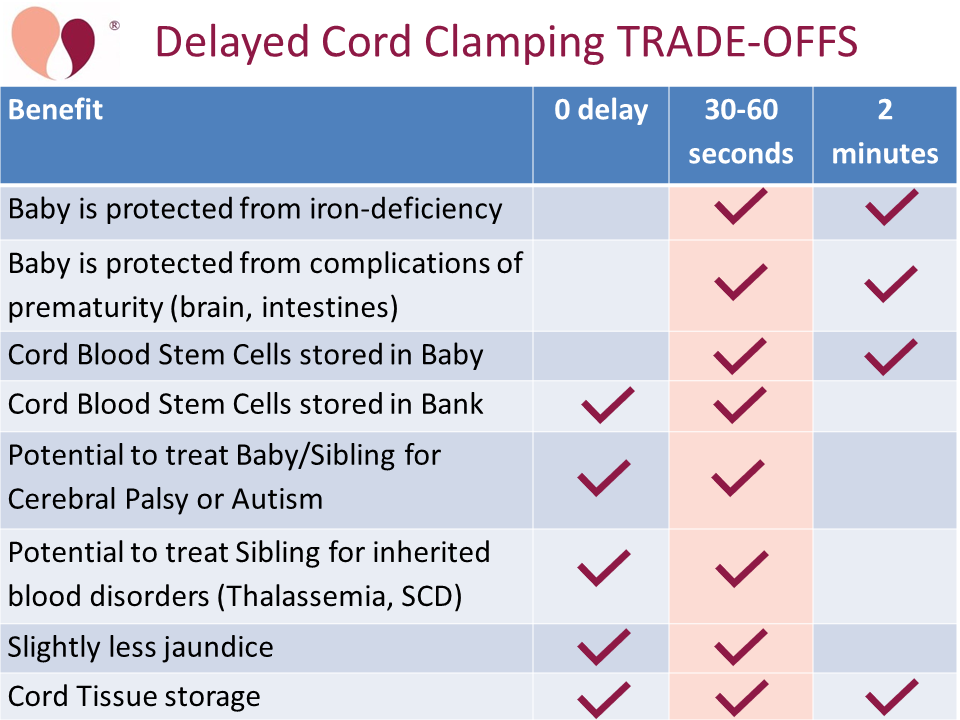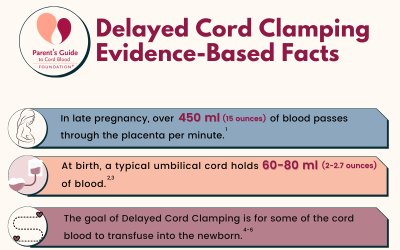You are here
What is Delayed Cord Clamping

Yes, you can have the best of both worlds, but only if you keep the clamping delay under one minute. The goal of delayed cord clamping, in full term healthy births, is to allow some of the blood in the umbilical cord to enter the newborn and boost the baby’s blood volume and iron supply1,2. This has some benefit for the baby, but it reduces the amount of cord blood that can be banked for the future health needs of the baby, the baby's siblings, and the baby's extended family.
Studies have shown that within the first minute after a healthy birth, the baby receives about 80% of the blood that will return from the umbilical cord, while at the same time the volume of cord blood that can be collected for banking is cut in half3-5. To delay any longer gives little additional benefit to the baby, but prevents cord blood banking altogether.
Medical societies of obstetricians and gynecologists do not recommend delaying cord clamping by more than a minute6-11. The World Health Organization (WHO) is in favor of longer delays because iron deficiency is a serious problem in poorer nations, for example as of 2021 the prevalence of anaemia among young children in Africa was 60%12,13. Midwives tend to be in favor of long delays, and advocate to “wait for white”, which means that the umbilical cord turns white because there is no blood in it14.
It is important for parents to make a decision about cord clamping time in advance of the birth, and talk to their healthcare provider clearly about their preferences. This Foundation has communicated with numerous parents who put a lot of effort into picking a cord blood bank, only to find that they did not have enough cord blood to bank, because at the time of delivery the responsible person waited too long before clamping the umbilical cord.
If you have an older child that needs cord blood for therapy, it becomes important to get a good-sized cord blood collection. Some situations where this might occur are an older sibling with Thalassemia, or an older sibling with Cerebral Palsy. In this case, parents should make certain that there is some one present at birth that understands the importance of the cord blood collection and has the necessary phlebotomy training to perform the collection correctly.
Donations to public cord blood banks must exceed a volume threshold in order to qualify for storage. This threshold is high, so that it is almost impossible to delay cord clamping and still collect enough cord blood for the donation to be accepted.
(References are at the bottom of the page)

Parent’s Guide
to Delayed Cord
Clamping

After a baby is born, the umbilical cord is clamped and cut. This may be done immediately after birth or it can be delayed, and different groups have different opinions on how long to wait. Delayed clamping allows some of the blood in the umbilical cord and placenta to flow back into the baby. Some groups believe in waiting for the cord to stop pulsating before the cord is clamped and cut. However studies show that most of the blood transfer from the umbilical cord to the baby occurs in the first 60 seconds1. Medical professionals consider delayed cord clamping to be waiting 30 seconds or more after the birth.


What do professionals say about Delayed Cord Clamping
The American College of Obstetricians and Gynecologists (ACOG) recommends 30-60 second DCC in premature babies born before 34 weeks pregnancy, based on clinical evidence that it reduces complications associated with prematurity2,3. The World Health Organization (WHO) recommends 60 second DCC for all babies, to compensate for varying levels of nutrition around the world4. In January 2017, ACOG started to recommend 30-60 second DCC for full term babies5. The immediate benefits of DCC for these babies are increases in blood volume and iron levels, while the long term benefits are still under investigation6. Parents should discuss their birth plan with their healthcare provider and whether DCC will be a part of that plan.
Can I have delayed cord clamping and still bank cord blood?
Delayed cord clamping will decrease the amount of blood that remains in the umbilical cord7, but it is still possible to collect and bank that cord blood. There is enormous variation from one baby to another in the length of the umbilical cord, the size of the placenta, and the amount of cord blood8. Some babies can easily have DCC and still have plenty of cord blood for banking, whereas others may have little cord blood left after DCC. Unfortunately, parents will not know in advance how much cord blood their baby has when deciding whether to plan for DCC.
How do I combine delayed cord clamping with cord blood donation?
When parents deliver at a hospital that accepts cord blood donations for public transplants, they should ask if the hospital has any policy on DCC. Due to the need for high stem cell counts in current transplant procedures, the percentage of cord blood collections that qualify for storage in public banks is low. When DCC is added, the percentage of collections that qualify for storage decreases as the length of the delay increases7. For this reason, parents should be aware that DCC may prevent their cord blood donation from meeting donation thresholds.

How do I combine delayed cord clamping with family cord blood banking?
While it is true that family banks will store small cord blood collections, parents should know that bigger cord blood collections are likely to be better for most therapeutic needs. Parents must weigh their individual priorities. Those families with an older child in need of stem cell therapy would likely make it a priority to obtain a transplant-quality cord blood collection and prioritize this over DCC. Other families with a full-term baby and no foreseeable need for stem cells may decide that the benefits of DCC outweigh the desire to store stem cells for future therapy. In summary, it is possible to have DCC and still preserve cord blood stem cells.
Should I still consider Cord Blood Banking
If my baby is premature, should I still consider cord blood banking?
Yes, both delayed cord clamping and cord blood banking have heightened importance for premature babies. On the one hand, DCC has clear benefits in preventing complications for infants born before 34 weeks of pregnancy2,3. On the other hand, premature babies have an elevated risk of cerebral palsy9, and clinical trials are underway evaluating the potential of cord blood as a treatment for this and related conditions. Research has shown that the concentration of stem cells is higher in the cord blood of premature babies10, so even a small amount of cord blood collected from these babies can be of therapeutic value.
What is the optimum delayed cord clamping time for parents choosing to bank cord blood?
The optimal DCC time is a topic of ongoing research6. The delay should be long enough to allow some of the blood in the umbilical cord to flow into the baby, but not so long that it is no longer possible to collect cord blood.
Studies suggest that the minimum delay of 30 seconds will accomplish both goals for most newborns1,6,7. It is important for parents to develop an individual plan with their healthcare provider, taking into account their known pregnancy complications, their risk of premature delivery, and any need to save cord blood for sibling therapy.
- Linderkamp Acta Paediatr. 1992; 81(10):745-50.
- ACOG Committee Opinion No.543, Dec. 2012, Timing of Umbilical Cord Clamping after Birth.
- Seidler et al. Pediatrics 2021; 147(3):e20200576
- WHO Guideline: Delayed Umbilical Cord Clamping.
- ACOG Committee Opinion, No.684, Jan. 2017, Delayed Umbilical Cord Clamping After Birth.
- Semple 2016.
- Allan et al. Transfusion. Mar 2016; 56(3):662-5.
- Nakagawa R et al, Transfusion 2004; 44:262-7.
- van Haastert et al. Pediatrics 2011; 159(1):86-91.
- Falcon-Girard et al. 2013; Cytotherapy 15(4): S21.
- Hooper SB, Binder-Heschl C, Polglase GR, et al. The timing of umbilical cord clamping at birth: physiological considerations. Maternal Health, Neonatology and Perinatology 2016; 2:4.
- Katheria AC, Lakshminrusimha S, Rabe H, McAdams R, Mercer JS. Placental transfusion: a review. Journal of Perinatology 2017; 37:105–111.
- Allan DS, Scrivens N, Lawless T, et al. Delayed clamping of the umbilical cord after delivery and implications for public cord blood banking. Transfusion Mar 2016; 56(3):662-665.
- Rodica Ciubotariu, MD PhD. Timing of Umbilical Cord Clamping and Impact on Cord Blood Volume Collected for Banking. Dec. 2016 Parent's Guide to Cord Blood newsletter
- Ciubotariu R, Scaradavou A, Ciubotariu I, et al. Impact of delayed umbilical cord clamping on public cord blood donations: can we help future patients and benefit infant donors? Transfusion 2018; 58(6):1427-1433.
- RCOG: Royal College of Obstetricians and Gynaecologists. Clamping of the Umbilical Cord and Placental Transfusion. Scientific Impact Paper No.14 Published February 2015
- SOGC: Armson BA, Allan DS, Casper RF. Umbilical Cord Blood: Counselling, Collection, and Banking. SOGC CLINICAL PRACTICE GUIDELINE No.328 Journal of Obstetrics and Gynaecology Canada 2015; 37(9):832-844.
- FOGSI: Federation of Obstetric and Gynaecological Societies of India. FOGSI CLINICAL STANDARDS Published 2016
- ACOG: American College of Obstetricians and Gynecologists. Delayed Umbilical Cord Clamping After Birth. ACOG Committee Opinion Number 814. Obstetrics & Gynecology 2020; 136(6):1238-1239.
- FIGO: Bianchi A, Jacobsson B, Mol BW; on behalf of the FIGO Working Group for Preterm Birth. FIGO good practice recommendations on delayed umbilical cord clamping. Int J Gynecology Obstetrics 2021; 155(1):34-36.
- ILCOR: Seidler AL, et al., ON BEHALF OF THE INTERNATIONAL LIAISON COMMITTEE ON RESUSCITATION NEONATAL LIFE SUPPORT TASK FORCE (ILCOR). Umbilical Cord Management for Newborns <34 Weeks' Gestation: A Meta-analysis. Pediatrics 2021; 147(3):e20200576.
- WHO: World Health Organization. Guideline: Delayed umbilical cord clamping for improved maternal and infant health and nutrition outcomes. WHO Guidelines Published 2014
- World Health Organization (WHO). Anaemia in women and children. WHO 2021 Edition
- ACNM: American College of Nurse Midwives. Delayed Umbilical Cord Clamping. Position Statement Published 2014

